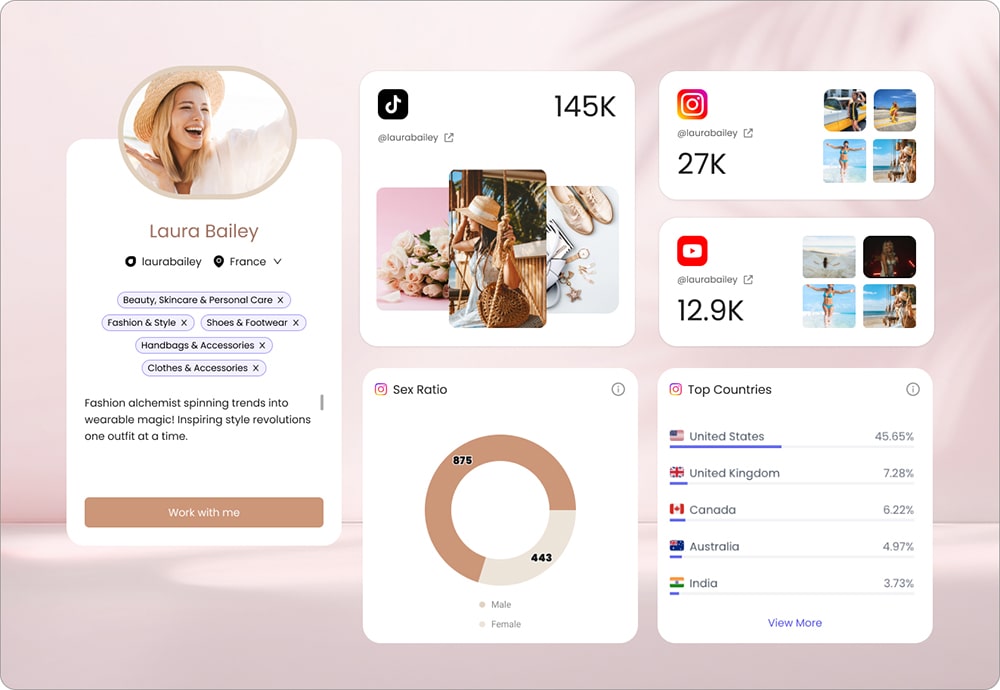Influencer marketing is one of the most effective marketing strategies today. Brands use It extensively to reach new and existing audiences, improve brand awareness, build trust, and ultimately improve sales through the trusted voice of influencers.
To effectively and successfully execute an influencer strategy, brands need, among other critical steps, to consider the financial side of the collaboration: influencers charge for their efforts, and these charges can vary from campaign to campaign significantly. This is often done through influencer rate sheets, a document used to determine the pricing of services of the influencers based on various factors.
In this article, we’ll take a look at what factors affect the influencer rate sheet and what factors you need to consider to understand the rating of influencers you want to collaborate with.
Factors affecting Influencer Marketing Cost
When it comes to influencer marketing cost, there is no one right answer. While it is often assumed that the following is the main factor when determining influencer compensation, in practice, there are quite a few factors that affect how much your influencer marketing campaign will cost.
Reach and Engagement of Influencer
Reach and engagement are two of the most important factors brands consider when choosing influencers to work with. These two performance indicators show how large of an audience the influencer can access, and how interested that audience is.
The reach is largely based on the number of followers the influencer has: the larger the number, the more people are likely to see the content creators post. Because of this, influencers are separated into four categories. We’ll take a look at each later in the article.
What comes to engagement, it’s the number that indicates how many people interacted with the post. The engagement rate is calculated based on likes, comments, shares, or saves the content receives. Higher levels of engagement indicate that people are interested in the product and trust the influencer enough to consider making a purchase. Engagement levels are one of the key factors to consider, and many brands choose to work with influencers with smaller followings and larger engagement rates than the other way around.
Platform and Content Type
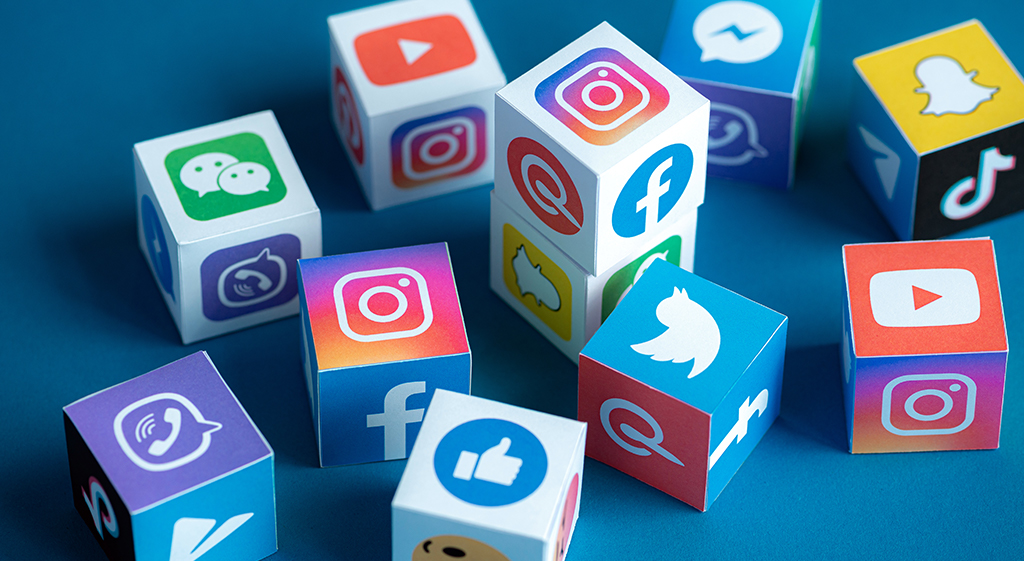
Platforms and audience demographics are another important factors that have an impact when creators build their influencer rate sheet.
Influencers charge different rates depending on the platform, and the payment for a reel on Instagram will differ significantly from the remuneration for a YouTube video.
The type of content the influencer will create for your brand will also have an impact on the pricing. Influencers will spend time and resources to create the content, and some type of content requires more time and resources to create than others. Additionally, consider how much content you want the influencers to create. Is it one picture, or several images, videos, and stories? The more effort it will require to create the content you have in mind, the more costly it will be.
Type of Campaign
There are many different types of campaigns in the frame in which you can cooperate with the influencers and each of them will reflect differently on the influencer rate sheet you are being presented with. A one-time collaboration, when the influencer makes a single sponsored post tagging your company page will differ significantly from a month-long affiliate program, or an even longer brand partnership.
You also need to consider that payments may not only be in the form of direct financial compensation, and can range from product discounts to gifts, especially in the case of long-term partnerships.
Location
Location can also have a significant role in determining the influencer rate. The most basic example of this is the area population: influencers in highly populated areas have the upper hand and can charge higher fees than creators living in smaller cities. This is especially significant in the case of non-E-Commerce businesses, like those with brick-and-mortar locations, or in the hospitality industry.
Influencer Niche
Lastly, the influencer niche significantly affects the pricing of campaigns. As a general rule, the more influencers are in the niche, the more options you will have, and the lower the prices will be as you’ll have negotiating power. For example, if you are looking to work with fashion and beauty influencers, you won’t have a shortage of options, while finding a qualified ophthalmologist who also collaborates with brands won’t be as easy, and can be much more costly.
These are not all, but the main factors that will affect the rates of your influencer marketing campaigns.
Different Types of Influencer Campaigns and Their Costs
As mentioned earlier, there are quite a few types of influencer campaigns. They can differ from one another by duration, posted content type and amount, and the goal, which will affect the cost of brand-influencer collaboration. Here are the five main influencer campaign types and how much they can cost.
Sponsored Content
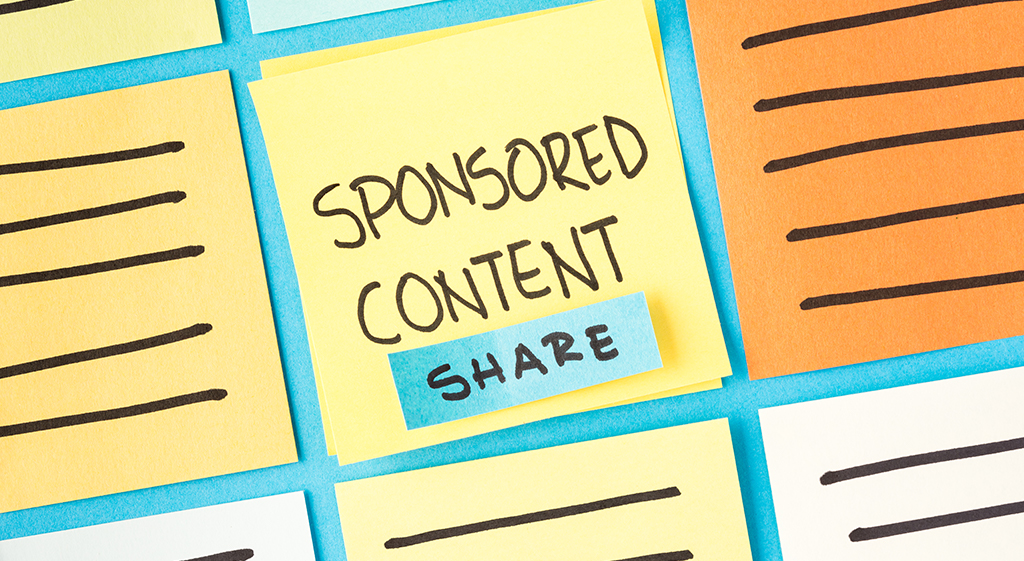
Sponsored content is one of the most common ways for brands and influencers to work together. Usually, this is a one-time collaboration in the frame of a single campaign. As part of sponsored content, the influencer creates one or two promotional posts and/or stories. The posts can promote the brand, a specific product or service, a deal, or a new collection.
Depending on the campaign type, the following size and engagement rate of the influencer, as well as the platform, the numbers in the influencer rate sheet can vary significantly. For example, on Instagram, the prices for a single post can range from $100/post and go as high as $5000/post and more, while on TikTok the price per post can start as high as $800 and go up to $7000. So, if you are looking to work with influencers on different platforms or even the same creator on multiple platforms, this will reflect differently on your influencer rate sheet.
Brand Ambassadors
The next type of collaboration is when the influencer becomes a brand ambassador. In contrast to sponsored content, these are long-term collaborations between the creator and the brand. The pricing for these types of partnerships will vary greatly based on campaigns, content type, as well as the special relationship the parties develop.
Much like in the case of sponsored posts, the larger the audience of the influencer and the longer the experience, the higher they will charge for collaboration. Another key element affecting the rate of brand ambassadors is exclusivity: it often happens that brands have an exclusivity clause in the contract, and the influencer will not work with the brand competitors. In this case, the payments will be significant, since the influencers will be giving up significant potential income.
Affiliate Marketing
Affiliate marketing, or referral marketing, is another common way for brand-influencer collaboration. In this case, brands offer influencers affiliate programs, providing them with custom links or discount codes. Influencers then promote these links and codes on their platforms, and every time someone makes a purchase, they make a small commission from the sale. Affiliate marketing campaigns may or may not include fixed payments, but more often than not the payments will depend on how many sales the creator brought.
Influencer Takeovers
Influencer takeovers are when an influencer takes over the account of the brand, typically for a day or a few hours, to create and share content on behalf of the brand. They are a great organic marketing tool, and as such, are extensively used as part of the brand-influencer collaboration.
The cost for influencer takeovers will vary significantly depending on the number of posts, influencer niche, their following size, and the platform. For example, a starting influencer with a smaller audience can charge several hundred dollars for a takeover, while a more established creator with a large follower base can ask for tens of thousands of dollars for their efforts. The rates will also differ based on the brand requirements.
Product Seeding

Last on our list is product seeding, a strategy when the brand provides the influencer with one or more products, which they then promote on their account. This is often done for new collections or products to-be-launched, but also for products already in the market. Usually, brands do the product seeding by sending over the curated products, but another strategy is allocating funds to the influencer, who then uses them to purchase products of their choice from the brand.
Influencers who are just starting to build their audience are often willing to accept the products themselves as a payment method, without additional financial compensation. Larger influencers, on the other hand, require a certain payment on top of the products.
In the case of product seeding as part of your influencer marketing mix, there’s a chance that it will have an impact on the final influencer rate sheet you are presented with.
Average Cost of Influencer Marketing
Now, although the pricings of the influencer campaign will vary depending on a plethora of factors and requirements from both sides, there are some averages that you can go by as you navigate the influencer marketing market.
Depending on the size of their following, creators can range from pico-influencers to celebrity influencers with millions of followers, and each of them has its own rates for doing business. Here’s a detailed breakthrough of each creator type, followed by a rate chart for them.
Pico-Influencers
Pico-influencers with 1 – 1,000 followers are the creators just starting their journey. Brands usually consider these creators effective in terms of engagement rates because, since the audience is yet very small, it’s highly likely that the followers are people genuinely interested in the creator and their work. Their content is also usually less polished and feels more authentic due to the friendly atmosphere they’ve created.
Nano-Influencers
Nano-influencers are the creators with 1,000-10,000 followers. They have a significantly larger following than pico-influencers, but still retain the authentic and friendly atmosphere they’ve created, and the trusting relationships they forged with their following. So, in this case too, their audience is usually highly engaged and is likely to be interested in the promoted products.
Micro-Influencers
Next up are micro-influencers, who have between 10,000 and 50,000 followers. These are the creators who don’t yet have celebrity status, but they have already built a considerable audience of highly-engaged followers in their niche. And it’s very likely that they spent years building their audience, so they usually can offer brands a wide reach and engagement rates higher than in the case of celebrity creators. The content is more polished than in the case of micro-influencers but is still authentic.
Macro-Influencers
Macro-influencers are social media personalities with a following ranging between 50,000-500,000 people. Macro-influencers are seen as influential figures in their respective niche, and due to the sheer size of their following, they can reach a large number of people and have a significant impact on their purchasing decisions.
Milli-Influencers
Milli-influencers is a new category of influencers, who have between 500,000 and 1 million followers. Similar to macro-influencers, milli-influencers offer brands significant visibility, although the engagement rates, in this case, will be significantly lower than in the case of, say, pico- or nano-influencers. Due to the size of their following, milli-influencers represent a valuable marketing tool to raise brand awareness and improve brand visibility.
Mega-influencers
Mega-influencers are creators with a following between 1 million and 10 million, and who have already achieved celebrity status. Influencers of this type can help brands achieve huge exposure, although their promotions can be viewed with skepticism. Because of their huge following, mega-influencers are often sought out by brands and can command higher fees for their services.
Giga Influencers
Next are giga-influencers, content creators with 10 million to 50 million followers. While the engagement rates in the case of giga-influencers are lower, the large following they have allows them to reach a wider number of people with their promotional efforts. Because of this, the rates of giga-influencers are significantly higher than in the case of micro-, macro-, and even mega-influencers.
Tera-influencers
Tera-influencer is a new term in influencer marketing and is used to refer to creators with an exceptionally large following standing between 50M and 500M. As the number of followers grows, so does the reach of the influencer; and tera-influencers can have a significant impact on a brand’s sales even if they catch the attention of only a fraction of their audience.
Peta-influencers
Lastly, we have peta-influencers, individuals with 500M to 1B followers. This influencer classification appeared only recently, with the boom of mainstream social media, and celebrities like Cristiano Ronaldo getting 550M followers on their Instagram accounts. As of now, there are very few peta-influencers, and those are mainly celebrities; however, more and more accounts are reaching the benchmark of hundreds of millions of followers, and soon there are to be more peta-influencers. When working with brands, peta-influencers are likely to have representatives and marketing managers and are likely to charge significant amounts. However, they can also bring unprecedented reach to the brands.
Now, let’s take a look at the price ranges per post on Instagram for all these influencer types.
Influencer Rate Sheet
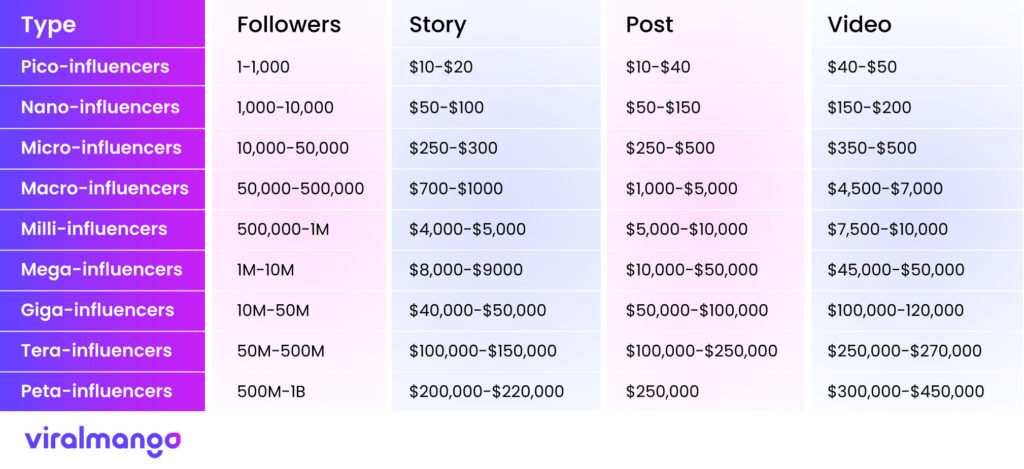
How to Negotiate Influencer Rates
When creators present their influencer rate sheets, more often than not they are open for negotiation to come up with the final number. While this can be a complex process, by being prepared, you can negotiate with them to achieve your desired outcome.
Define Campaign Goals
The amount you’ll need to pay to the influencers will significantly depend on your campaign goals. Therefore, it’s essential that you identify what are your needs and expectations, and what are you looking to achieve through your campaign. After you’ve identified your main campaign goals, you need to clearly communicate them to the influencer. Share with them what you are looking for and how they can help you achieve it. This will help the influencer understand what type of content they will need to create and at what frequency, information that directly affects the influencer rates.
Research the Influencer
Another important step is knowing who you want to work with, therefore, it’s critical that you research the influencer, as well as their competition and the average market rates. Before you start negotiating rates, research the typical rates influencers with similar audiences and reach and engagement rates are charging. Gather as much information about industry standards as you can. This will make it clearer for you what is and is not reasonable to invest as well as provide a starting point for your negotiations.
Identify Value Proposition
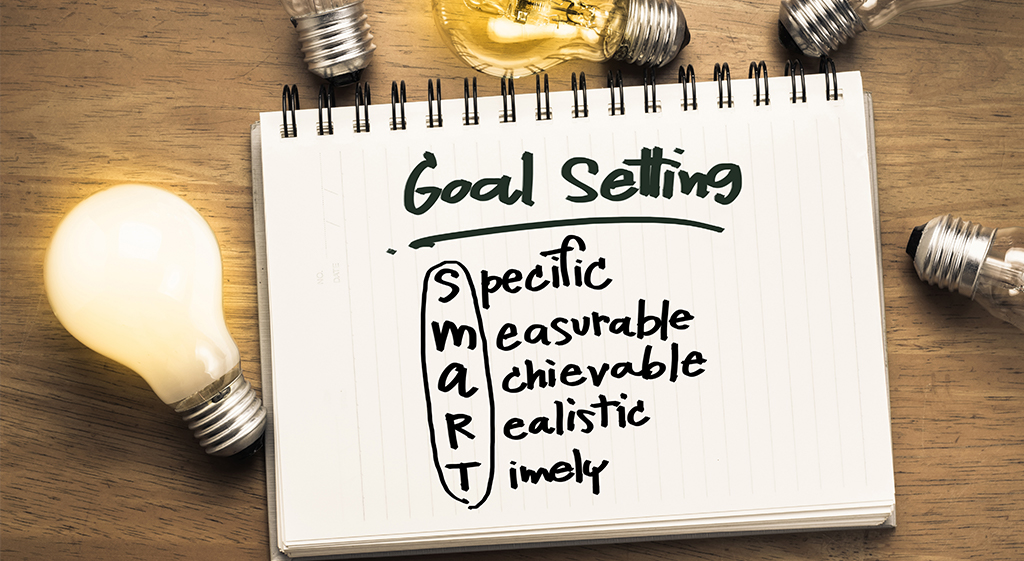
Think of what makes you stand out from other brands in your niche, and what it is that you are offering to the influencer beyond financial reward. This is important because influencers have spent years curating their audience, and value their opinion and trust as much as the audience trusts them. Therefore, most influencers won’t work with brands whose values don’t align with theirs, as they want to bring value to their followers.
Highlight your values and your unique offering to demonstrate why the influencers should want to work for you, and maybe even give you a wiggling place when negotiating the influencer rate sheet.
Be Clear on Deliverables
Last but not least, when preparing to negotiate an influencer rate sheet, you need to be crystal clear on the expected deliverables. This will ensure that they know what outcome is expected of them so they can focus on achieving it. It will also let them know what channels you want to collaborate on, what is the quantity and quality of the expected content, what is message you want to deliver, and everything in between. Knowing this, influencers can pre-plan the campaigns and understand the time and resources it will require them to complete.
Conclusion
The estimates that we have given here will give you an approximate idea of how much your influencer marketing campaign can cost you. However, the cost of your influencer campaigns will vary significantly. Factors such as your niche, the influencers you want to work with, their audience size and reach, the platform you want them to promote your products on, as well as the type of content and the frequency at which they post, will considerably affect the cost of your influencer marketing efforts.
Influencer rate sheets are a useful tool for both influencers and brands to define the cost of their collaboration, but they are not something fixed. Think of them as a place to start negotiating the terms of your potential collaboration and a way to achieve an agreement fitting both your brand and the influencer.
By Rem Darbinyan
Revolutionizing industries with AI, Rem Darbinyan is the CEO of ViralMango and an entrepreneur, AI expert, and influencer marketing strategist.

Reviewed By Rem Darbinyan
Revolutionizing industries with AI, Rem Darbinyan is the CEO of ViralMango and an entrepreneur, AI expert, and influencer marketing strategist.

